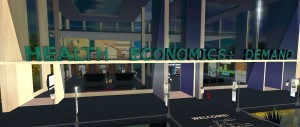Course Description
Economics of Health and Wellness [HLWL-3600-10 (Online)] — [A completely online course.] Starting with a review of basic economics concepts, this course provides an introduction to the application of economic theory to the field of health and wellness. In particular, students will study the individual as a producer of health/wellness and as a consumer of healthcare services. Also, the role of physicians, hospitals, insurance providers, and the government in the health and medical care marketplace will be examined. Finally, the role of universal insurance and international comparisons of the efficiency and effectiveness of health care systems will be studied.
[Optional] Virtual World Learning Activities

What am I supposed to do now that I have logged into the Tulane SCS Metaverse?
(1) Explore the different economics of health and wellness learning activities (that are located on the SCS Campus South island).
(2) While most of the learning activities can be completed individually (and asynchronously), if you are interested in participating in a real time activity with other members of the class and/or the course instructor, sign-up for one of activity times listed on the Virtual World Forum on the “Main” course site discussion board.
(3) Take the “Participant Survey” (to earn half of the module two/three discussion component points) and provide important feedback to your course instructor. Note: If you participate in the virtual world learning activities during module two and module three, you need to take two different surveys. In other words, you will need to take a survey for each module.
What economics of health and wellness learning activities are included on the SCS Campus South island?
(1) Demand for health and wellness simulations are located in the building on the east side of the island.
(2) Supply of health and medical services simulations are located in the building on the west side of the island.
(3) Global comparisons of health care systems — including overviews of the health care systems in Japan, Great Britain, Germany, and Canada — are located in the building on the south side of the island.
(4) An implementation timeline and other materials related to the Patient Protection and Affordable Care Act are located in the stadium on the north side of the island.
(5) Orientation posters [re: navigating around a virtual world] are located behind the stadium on the north side of the island.
What course learning outcomes do the above virtual world learning activities support?
The virtual world learning activities on the SCS Campus South should contribute to your understanding of:
(1) How health care markets differ from other market types, including the unique role of health insurance in the market.
(2) How lifestyle choices affect health, including both direct effects on health and indirect effects on earnings.
(3) The monopolistic competition market structure for physicians and physician-firms influences the prices in these markets.
(4) The economic implications of federal insurance programs (Medicae, Medicaid, and Supplemental Children’s Health Insurance Program) – in terms of demand, risk management for individuals, and cost.
(5) How the costs and benefits of the United States health care system, including why the United States has the largest per capita health care spending among the developed nations, yet worse health outcomes than nations spending less per capita for health care. Also, will understand how other nations’ system choices differ from the United States’ health care system.